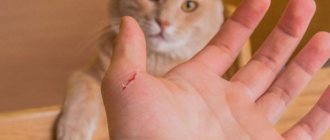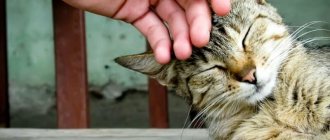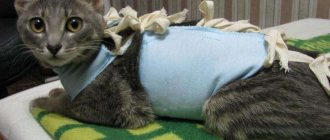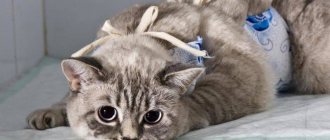What's wrong with the cat? Why doesn't the cat feed the kittens?
Cats are endowed with a strong maternal instinct and from the first minutes of life they carefully take care of each of their babies. But it also happens that females abandon and abandon their offspring. Why is this happening? What's wrong with the cat and what to do if the female doesn't have milk?
Reasons why cats may abandon kittens:
- Health problems, difficult childbirth, postpartum complications (mastitis, eclampsia, endometritis, pyometra). For example, with eclampsia (milk fever), cats' behavior changes dramatically. Females refuse their cubs, may show aggression towards them, or even eat their own litter. With mastitis, due to inflammation of the milk bags, milk secretion is disrupted. The cat does not allow her to touch her nipples or belly, and cannot feed the kittens.
- Too early pregnancy and childbirth. Unsterilized outdoor cats can become pregnant during their first heat, before reaching full sexual maturity.
- Non-viable offspring. Cats abandon weak, sick kittens.
- Hormonal disorders caused by stress, improper care of the cat during pregnancy, health problems, disruptions in the endocrine system, and others, drugs that suppress the rut (“Anti-sex”).
- Lack of lactation. Colostrum appears in cats about an hour after the kittens are born.
- First birth. Despite the fact that cats have a highly developed maternal instinct, due to inexperience, especially if the female gives birth for the first time, she abandons the babies, not knowing what to do with them.
- Poor care during pregnancy, stress.
Rules for preparing for childbirth, and what to do if a cat gives birth
Many owners who have refused to sterilize their pet are interested in the question: what to do if the cat gives birth? When a person gets a cat, he must immediately decide whether he will sterilize it or not.
What to do if a cat gives birth?
Sterilize or deliver?
Of course, the most convenient way for the owner and the most humane way for the animal to solve the problem is sterilization. Having undergone a simple operation once, the cat will be free from natural urges and will be able to feel normal, living in the limited conditions of a city apartment. But for those who are going to let their pet outside, it will be much more convenient and less troublesome if the cat is sterilized. First of all, this will get rid of the crowds of fans who will definitely gather at certain times of the year in the yard and under the door. They can seriously fray your nerves both by staining all the walls and with their endless nightly serenades.
After sterilization, the cat will not produce kittens
But the most important advantage of sterilization is that the cat will no longer produce kittens. That is, its owner will not have to rack his brains about where to place the babies.
If the owner of the animal decided not to go against nature and refused sterilization, he should know what to do if the cat gives birth, because more than once he will have to watch how little kittens are born. As a rule, cats easily cope with this task without outside help, but sometimes childbirth can occur with complications. In this case, all hope lies only with the person who is obliged to help his pet. And if a cat gives birth for the first time, every owner should know what to do in this case.
At what age can a cat give birth?
Those owners who have not previously encountered cats should remember that sterilization should not be shelved, since these animals can begin to bear offspring very early. The average cat goes through puberty by the age of eight months. If a cat owner plans to have kittens, then it is better to bring the animal with a partner after a year. The best option would be the fourth heat.
A cat's pregnancy lasts about two and a half months.
It is very easy for a person who has a cat at home to understand when she begins to go into estrus, that is, into heat. Based on the behavior of the animal, it immediately becomes clear that the cat has matured.
The entire period of estrus in cats can be divided into three stages. The first lasts about three days. At this time, the animal will constantly rub against its legs and require a lot of attention. Then there will be several days of rolling on the floor meowing loudly. At this time, the cat often walks with its tail moved to the side. Then comes the third stage, when the discharge is still there, that is, the cat attracts males, but at the same time it becomes aggressive towards them. If fertilization does not occur, this period can last up to 20 days. In a fertilized cat, it is reduced to one week.
A cat's pregnancy lasts about two and a half months. At one time, an animal can give birth to an average of four to seven kittens, but a lot depends on the breed of the cat. A person should carefully monitor when a pet goes into labor. If they are premature, which is not uncommon for the first time, then the babies are unlikely to survive. It’s also bad when a cat can’t give birth for a long time.
For the expectant mother you need to prepare a bed
Important! If the cat cannot give birth, contact a veterinarian immediately, otherwise the animal and the kittens will die.
What to prepare for childbirth
The closer the kittens are born, the more attention the cat owner should pay to preparing for this event. First of all, you need to prepare a bed for the expectant mother; it is advisable to place it in a warm place. It’s better to lay down old things that you won’t mind throwing away, as they will definitely get dirty. It should be noted that synthetics can have a bad effect on the condition of newborns, so it is better to use natural fabrics.
In addition to the fact that the owner must know what to do when a cat gives birth, he must know what may be needed during childbirth.
A powdered cat's milk replacer may be needed if the birth is difficult.
You should prepare a set of necessary things. This includes:
- surgical gloves;
- scissors;
- clean cloth or towel;
- petrolatum;
- warm heating pad;
- dry cat milk replacer;
- antiseptic, for example alcohol.
Milk will be needed in case the cat has a very difficult and protracted labor, that is, she may not feed the babies at first. In this case, a person will have to take on the role of the cat's mother.
It is very important that the place where the cat will give birth is quiet and not too bright. You don't need to gather a whole crowd to deliver an animal. In most cases, cats cope well with the task on their own, and those present will only irritate her.
Before giving birth, the cat begins to meow loudly
How to understand that labor has begun
If a cat begins to give birth, its owner will immediately notice. The animal will begin to behave strangely as it begins to look for a suitable place.
On a note! You can determine the approach of childbirth by such signs as loud meowing, which will be accompanied by the cat throwing from corner to corner.
If a cat begins to give birth, every owner should know what to do. To make your pet feel calmer and more comfortable, you can take it to a pre-prepared place. The cat needs to be petted so that it finally calms down.
Before giving birth, the animal will constantly lick itself and breathe very heavily. Considering that during this period the cat will feel severe discomfort, it can constantly roll on its back and expose its belly to be stroked. At this time, it is very important for many cats that there is a person nearby whom she loves, with whom she has an established emotional connection.
First birth
If your pet has not become a mother before, then you need to monitor the birth especially carefully and know what to do if the cat gives birth. As a rule, animals instinctively do everything right. However, when it comes to the first birth, the cat may simply be confused. The most common mistake an animal makes is that during childbirth the cat begins to sit down. As a result, the kitten, which passes through the birth canal, cannot exit and becomes stuck. This often leads to fetal death. The person’s task in this case will simply be to ensure that the young mother does not sit down.
Many people who give birth to an animal for the first time are concerned with the question: if the cat did not give birth to all the kittens, what to do? In fact, you don’t need to think that all the babies will be born one by one. It is quite normal for one kitten, or even a couple, to appear a few hours later than the rest. If the cat feels fine, then no action needs to be taken.
The most common mistake an animal makes is that during childbirth the cat begins to sit down
It is possible that the person will need help cutting the umbilical cord. To do this, you need to prepare sharp scissors and an antiseptic.
Attention! The umbilical cord is tied with a thread at a distance of about 2 cm from the baby’s tummy, cut off and cauterized (with peroxide and brilliant green, for example).
Experienced mothers gnaw through it themselves, but during the first birth this may not happen. Already born babies can be placed on a heating pad away from their mother if she has not yet given birth to all the kittens. This way you can protect them and prevent the cat from crushing its offspring. It is important that babies do not become hypothermic, otherwise they will lose their sucking reflex and die.
After the birth of each kitten, the placenta should be released. This needs to be monitored. If for some reason it does not come out, the person must remove it by hand. This is what surgical gloves come in handy for. Sometimes cats eat the afterbirth. This is considered quite normal.
It is important that kittens do not become hypothermic after birth
Helping a cat during labor
Don’t worry and don’t torment yourself with the question of what to do if a cat gives birth, if the process of giving birth to kittens is within normal limits, the cat is calm, licks her babies one after another and warms them with her body. You don't need to take any action. Nature will do everything itself, and the owner can only make sure that everything is normal. However, there are also situations when an animal cannot give birth without outside help.
For example, the kitten should come out head first. But what to do if a cat gives birth to a kitten with her paws first? This will be very difficult, and most often the kittens will just get stuck. If within ten minutes the cat has not been able to give birth to this kitten, it must be sent back, where it must turn over and come out as it should be.
The kitten should go head first
If the kitten is almost out, but then gets stuck in the birth canal, you can try to carefully pull it out. But this must be done extremely carefully and not pull too hard, so as not to damage the small body. It is advisable to try to grab the baby by the neck folds or torso, but not by the head.
Most often, kittens get stuck in cases where the birth canal dries out. This happens when labor lasts for a very long time. Then Vaseline will come to the rescue, with which you need to thoroughly lubricate everything.
Another emergency may be the birth of a kitten in the birth bladder. The person must cut the shell and take out the baby. After this, it is advisable to wipe the kitten with a clean towel and place it on a heating pad, or simply return it to its mother, who will then do all the necessary work.
If a kitten gets stuck during birth, Vaseline will come to the rescue
A sign that everything is fine with newborns is their thin squeak. However, some kittens may not make these sounds. This suggests that not everything is all right with the baby. In such a situation, a person can try to resuscitate the cat. To do this, you need to take it by the hind legs and carefully shake it quietly, but not too much, so as not to break the spine. Often this is enough to revive the baby.
If a cat gives birth for a long time, every loving owner, worried, thinks about what to do. If the cause is weak contractions, you can use a special stimulant. Similar injection preparations are sold in veterinary pharmacies. But they must be used very carefully, and even better, call a doctor in any unclear situation. If an animal is really dear to a person, he will not spare money to hire a specialist, at least when it comes to the first birth. Then you won’t have to wonder what to do if your cat gives birth.
It is better to entrust the first birth of a cat to an experienced specialist.
Cat owners need to know that the process of giving birth to kittens is greatly influenced by the course of pregnancy. If the animal is properly cared for for two and a half months, if the expectant mother receives all the necessary vitamins and proper nutrition, then the birth will most likely take place without complications.
Rules for preparing for childbirth, and what to do if a cat gives birth was last modified: September 6th, 2021 by Ekaterina Efimova
Rules for feeding kittens without a mother
If a cat refuses to feed her babies, has health problems, postpartum complications, or, unfortunately, the pet died during childbirth, owners should know the rules for feeding kittens without a mother.
If the kittens are orphaned, try to find another nursing cat in the next few hours. This is the best option, because kittens receive useful substances and protective antibodies with milk and colostrum.
To get another cat to accept someone else's children, take a “donor” kitten and wipe the foundling on it.
If you are unable to find another nursing cat, you need to act correctly and immediately. There are many nuances regarding feeding and care that will save the lives of kittens. It is important not only to provide regular nutrition to children, but also to create safe, favorable living conditions.
Examine each kitten. The babies are not yet standing on their paws, but if the kittens are not sleeping, they are constantly moving (crawling). Healthy kittens have warm skin, a rounded tummy, and a well-defined sucking reflex. If the kitten is lethargic and cold, this is an alarming signal . Perhaps the baby has health problems or is not viable. In non-viable kittens, the sucking reflex is weak or completely absent.
Important! Inspect and monitor the condition of newborn kittens daily, several times every morning, including at night.
Hungry kittens show anxiety, constantly squeak, and try to suck on a finger. In order for the babies to become stronger, grow normally, gain weight, and develop well, it is important to follow certain rules for feeding newborn kittens.
A well-fed kitten behaves calmly. His abdomen is slightly distended and he falls asleep immediately after eating. If the kitten continues to squeak, it means that he has not yet received the portion he needs to be satisfied.
Other care details
After feeding, use light, clockwise circular motions to massage the base of the kitten's tummy. Mother cats constantly lick the kittens' abdomen and genital area, thereby stimulating their digestion.
Also remember that in the first two weeks, kittens cannot pee or poop on their own. Therefore, after eating, you need to massage the tummy and lubricate the genitals with a sterile swab dipped in warm water.
To maintain the temperature necessary for life and metabolism, kittens need to be warm. Use a heating pad wrapped in a terry towel or a special lamp. If kittens are not warmed, they will die.
What to do when your cat gives birth for the first time
Having adopted a female animal, the owner must immediately decide on her future. If he does not want to have trouble with offspring, then the cat must be sterilized. And when the owner decides to give the pet the opportunity to become a mother or the mating occurs by accident, then it is necessary to acquire information about how to properly prepare her for childbirth and what can be done to help.
About preparing for the arrival of kittens
So, you are already convinced that your pet is really pregnant, her tummy is noticeably rounded. A week before the upcoming birth, the expectant mother needs to arrange a nest, that is, a maternity hospital. This can be an ordinary spacious box or a box with low sides. It should be comfortable for the cat to climb there. Cover the bottom with natural fabric. Let the cat sniff the nest and get used to it. If you don’t do this, then she will look for a place to give birth herself, and it could be a closet, an easy chair where she likes to sit, or the owner’s sofa. It is recommended to place the box in a quiet, uncrowded place, perhaps near a battery. The cat should feel comfortable and calm there.
As a rule, healthy animals successfully cope with the birth of their offspring on their own. But still, during the first birth, especially if the cat is too round and the litter is expected to be large, you need to have the veterinarian’s phone number at hand.
It should be taken into account that a day or two before giving birth, the expectant mother may refuse food. She only drinks water. And that's quite normal. Let this behavior be a signal to you.
As a rule, on the day of birth, the pet begins to meow pitifully and rub against the owner, as if calling for help. This happens when the cat is very attached to him.
About the birth process
The signal that labor detail has begun is discharge from the birth canal. At such moments, the pet breathes frequently. Her stomach begins to contract in waves, signaling contractions. In fairness, we note that in cats the birth of offspring is much easier than in women. Yes, and faster. During contractions, you should not touch the cat, you can only be nearby and calm it with your voice. The very presence of the owner nearby acts as support for the pet. The first contractions of the expectant mother can last about two hours. With a normal birth process, after contractions the first pouch with a kitten appears. The pet chews through the bubble on its own and immediately clears the mucus from its baby’s face. Next, she gnaws the umbilical cord and eats the afterbirth, which follows each baby. At this time, the owner should not do anything. Just stay nearby and don't interfere with the process. The cat may need help if it has not chewed the umbilical cord for some reason. Then you need to bandage it with thread at a distance of 3-4 centimeters from the abdomen, cut it with sterile scissors, treat it with alcohol or other antiseptic.
Please note that normally kittens appear one after another with a break of 10 to 60 minutes.
How to understand that a cat has given birth to all kittens
So, in most cases, the first time a cat’s offspring are not numerous. Usually this is 1-3 kittens. With subsequent births, their number may increase. But every rule has its exceptions. Therefore, sometimes a cat gives birth to her last kitten after a long interval.
You can understand that the birth is not over by the behavior of the pet. She looks tired, resting, but does not care for the kittens. Such a rest can last several hours. If the owner has suspicions that the birth process is not yet completed, then you can try to carefully palpate the cat’s belly. If all kittens are born, then it will be soft, without compactions. Sometimes even an inexperienced owner manages to feel the unborn baby. If the cat cannot produce it herself, then you need to seek help from a veterinarian. He will definitely determine that labor has not really ended and will administer oxytocin to the woman in labor. This is a uterine contraction stimulator that will help the last kitten be born and help cleanse the uterus of mucus.
It is worth noting that the last baby in most cases is the weakest. It may be born dead, especially if the litter is numerous. The first one is the strongest. Therefore, if they want to keep one baby, they choose in favor of the first one.
Next, the cat rests, and the owner’s task is to provide her with complete peace and provide fresh water nearby. As a rule, mothers do not eat for 24 hours after giving birth. After some time, try to change the cat's bedding. Her children should be touched as little as possible.
What you need for feeding
To feed your pets you need to purchase everything you need.
What you need to feed a kitten:
- Special mixtures, nutrition.
- Cat milk substitutes.
- Pipette, disposable syringes without a needle or with a rubber nozzle;
- Bottles with nipple. Use the Catac kitten feeding bottle.
- Disposable moisture-absorbing diapers, cotton pads.
- Medicines for intestinal colic for infants.
Important! There are ready-made kits on sale for feeding small kittens, which contain all the necessary tools and utensils.
Please note that whole cow's milk is not suitable for feeding a newborn kitten. The lactose contained in it is not absorbed by the gastrointestinal tract of kittens and can cause intestinal upset.
Until you purchase a cat's milk substitute or infant formula, it is better to use goat's milk for feeding.
If this option is not possible, boil low-fat cow's milk, dilute it with water by half, add one raw yolk, a little honey or sugar or 3-4 drops of glucose. For 500 ml of milk 1 egg yolk, 4 tsp. Sahara.
Feeding newborn kittens - all the nuances of a complex process
Newborn babies abandoned by a cat need not only nutrition, but also special care. First of all, it is necessary to ensure that the air temperature meets the standards. So, at first, a week-old kitten feels comfortable in a room where the air temperature is in the range of 29…32 °C.
It is also important to monitor the cleanliness of the cat’s “nest” and the hygiene of small kittens. Remember to thoroughly wash feeding bottles and change diapers used as bedding. Unsanitary conditions can lead to the development of dangerous diseases.
Feeding newborn kittens with a cat is not difficult. Even if it is possible to “borrow” a cat for feeding, the situation does not seem so problematic. What to do if there is nowhere to get milk?
You cannot offer regular goat or cow milk to newborns; the composition of milk in cats is significantly different. Feeding like this will cause more harm. But there is a way out.
- Pharmacies sell formulas for kittens after birth, deprived of mother's milk. Their composition is as close as possible to breast milk, the kittens will receive the same beneficial microelements and grow fully. Beaphar Kitty-Milk and Royal Canin (Babycat Milk) mixtures are especially popular.
- You can use baby formula for babies, which is sold at any pharmacy.
- Another option is to prepare the product yourself.
For artificial feeding, a syringe, a pipette, or a medicine bottle with a rubber dispenser cap are used. The veterinary pharmacy sells special bottles and nipples designed for these purposes. When feeding, you need to make sure that the kitten does not swallow a lot of air, this will lead to bloating and pain.
Food is prepared immediately before use. The temperature should initially correspond to the kitten’s body temperature, and as it grows, lower it to room temperature.
Feeding methods
It is important to hold the kitten correctly during feeding.
- Don't turn it over on its back. It is not right.
- Place the baby on your lap or, best of all, use a container with low sides, which is covered with a cloth or diaper before feeding. The hind legs should rest on the bottom, and the front legs on the sides.
- Gently lift the muzzle up, lightly pulling the animal by the scruff of the neck. Over time, the fluffy will choose a comfortable position for eating.
- While feeding, pet and talk in a gentle tone to the kitten.
Important! For the first five days, kittens are fed with a pipette. If an older kitten refuses to eat from a bottle with a nipple, continue to give the mixture with a pipette or use a syringe (No. 2), pouring food drop by drop with its mouth slightly open.
Before giving food to small pets, immerse the bottle in warm water. You can feed babies only with mixtures at room temperature (35-36 degrees). Feed kittens in a warm, draft-free room.
After feeding, kittens may burp in the first two weeks of life. Place it on your chest and stroke the animal's back for a few minutes until it burps.
Feed the kitten if it is warm and its temperature is not lower than 35-36 degrees. Low body temperature slows down metabolism and can cause aspiration pneumonia.
If your cat is cold, place him near a heating pad and as soon as his body temperature rises, start feeding him. After eating, in addition to massage, wipe the kitten's face with a damp sterile cloth soaked in warm water. Rinse well and disinfect the bottles (in the oven, microwave).
Use new pipettes and syringes for each feeding, since kittens with fragile immunity are very sensitive to infections. Tools and utensils for feeding must be sterile.
Monitor your kittens' weight. Daily weight gain is 20-25 grams. At two weeks of age, kittens should weigh approximately 200-210 g depending on the breed, and at three weeks - 280-300 g.
How to feed a newborn kitten without a cat?
Kittens cannot lap on their own; they must be fed with a syringe or pipette. A mandatory condition is a tummy massage. It is carried out immediately after feeding the crumbs. It is necessary to make longitudinal movements in the direction from the head to the tummy, lightly massaging.
How to feed a newborn kitten without a cat:
- There is no need to give kittens water. Everything you need is contained in the mixture. Under no circumstances should babies be fed pure cow's milk.
- It can negatively affect the digestive system of animals. Kittens that are fed milk often experience diarrhea, indigestion, constipation, or even diarrhea. It is necessary to prepare a special mixture.
- Starting from two weeks of age, it is necessary to purchase soft, wet food for kittens. It is added to the milk mixture in an amount of approximately 1/3. Gradually the amount of wet food in the mixture increases. Already at the age of 3 weeks, the kitten can be fed wet food.
Cat feeding puppies
Feeding mode
In the first month, it is very important for the health of small pets to follow a routine and feeding regime. During the first week, kittens nurse from their mother cat approximately every 60-70 minutes for 24 hours.
Feeding schedule for kittens up to a month:
- For the first 14 days, feed the kittens every two hours at night and during the day. The norm is 30 ml per 100 grams of kitten weight.
- From the second to the third week - once every 2.5-3 hours. The norm is 35-40 ml per 100 grams of weight.
- Starting from the third week, kittens are fed every 3-4 hours during the day and at night - every 5-6 hours.
- From 30-36 – every 3.5-4 hours during the day and once at night. The norm is 4045 ml per 100 grams of weight.
- Accordingly, owners should feed them with the same frequency, without losing their schedule and daily routine. Stick to the regimen until the kittens begin to eat on their own.
What to feed a kitten without a cat for 1 month?
Starting from 2-3 weeks of age, babies must be switched to standard food.
What to feed a kitten without a cat for 1 month:
- In no case should dry food or wet canned food be introduced into the food at the initial stage. Kittens must be switched to dry food starting at 4 weeks of age.
- Never use food for adults, as it does not contain enough minerals and trace elements to meet the needs of babies.
- How do you know that a kitten is developing correctly and is healthy? It is necessary that at the age of about 1 month the kitten weighs 250-500 g. This indicates that there are enough nutrients and food for the baby.
Kids
Milk substitutes and formulas
The gastrointestinal tract of newborn kittens is vulnerable, so we do not recommend feeding them whole milk until one month. There are special milk substitutes and mixtures for small kittens in powder and liquid. They can be purchased at veterinary pharmacies, veterinary clinics, and online stores.
Before feeding, read the information provided by the manufacturer on the packaging. The instructions contain an approximate daily dose of food for kittens of various age groups.
Pour the prepared food into a bottle and place it in boiling water. Cat milk replacers should be at least 36-38 degrees. Before feeding your pet, check the temperature of the mixture. It, as already noted, should be at room temperature.
Industrial cat milk substitutes
Industrial cat milk substitutes are an ideal option for artificial feeding. Their composition is almost similar to cat milk. Contains all the beneficial substances for the health and growth of kittens (proteins, vitamins, amino acids, minerals).
The best manufacturers and brands of cat milk substitutes:
- Babycat Milk ROYAL CANIN. Complete complementary feeding from the first days of a kitten’s life until 2 months. Contains a high amount of protein.
- Katzenmilch. For feeding from the first days of life.
- Hartz. Can be used as a supplement for pregnant cats and feeding newborn kittens.
- Gimpet Cat-Milk.
- Nutri-Vet.
- Just Born.
- Nurturall-C.
- Dolfos Dolmilk Cat
- Beaphar Kitty milk.
Cat milk replacers can also be used for the first complementary foods, after weaning, or if the female does not have enough milk (the daily dose is reduced by 2-3 times).
Infant milk formulas for kittens
Store-bought infant formula for kittens is suitable for feeding without sugar or additives. (Nutrilon, Malyutka). They are diluted with twice as much water as indicated in the instructions.
The mixture is prepared before each feeding. You can store prepared food in the refrigerator for no more than 20-24 hours. Fresh mixtures are very well absorbed by the gastrointestinal tract of kittens.
Scott's Kitten Mix
This is a multi-component composition for artificial feeding of furry pets, prepared according to a special recipe.
Compound:
- 15 ml whole milk powder;
- 50 ml cow's milk;
- 3 g dry yeast;
- one egg yolk;
- 50 g whipped egg whites;
- 1 g vegetable oil;
- 4 grams of sugar.
All ingredients are mixed until smooth in a ceramic bowl. Warm up to 37-38 degrees, put it in a bottle or syringe and feed the kitten.
Scott's kitten formula is ideal for frail newborn kittens.
Tailing mix for kittens
Tailing's mixture for kittens can easily replace an industrial cat's milk substitute.
To prepare you will need:
- Homemade milk – 25 g;
- Powdered milk – 5 g;
- 5% glucose – 4 g;
- Multivitamins for kittens – 1 g.
Mix the components with a whisk until smooth. When using powder components, make sure that they are pre-crushed. Before feeding, the kitten is warmed up to 37-38 degrees.
Prepared food cannot be stored in refrigerators for more than two days!
Reasons for abandoning offspring
Not every pet has such a strong maternal instinct as a cat. From the first minutes of the kittens' life, she fiercely protects and cares for her offspring.
A cat may refuse to feed newborn babies due to illness or stress. As felinologists note, a cat can leave the “nest” and abandon its offspring due to age, stress and other circumstances. It is important to understand that there is no such thing as a “bad cat mom.” If an animal refuses to feed kittens, you need to look for psychological or physiological reasons.
Non-viability of offspring
At an instinctive level, a cat detects a sick or hypothermic (low body temperature) kitten and refuses to nurse it. This kind of situation is often observed with a large litter: the female gives the right to life to stronger babies, feeling that there is not enough milk for everyone.
A weakened kitten is not always viable. A person can deliver such a baby by providing him with the correct temperature conditions, proper conditions of detention and feeding him with milk formulas.
Stress
Excessive fuss and attention of the owner to the process of delivery and newborn kittens can cause stress in the animal. As a result of accidental or intentional human intervention in the life of an animal, a cat may refuse to raise and feed its offspring.
Age
According to veterinarians, a cat that has not reached the age of puberty, but has already become a mother, does not want to nurse a litter. There is no need to rush and take the kittens from the “nest”. On the second day, the animal's maternal instinct may awaken.
The owner’s task is to provide the pet with complete rest and feed newborn babies with formula milk during the first day of life.
Lack of milk
One of the common reasons why a female abandons her offspring is the lack of milk due to hormonal imbalance as a result of premature birth. The cat began to give birth before the body had completely adjusted to a new way.
Foreign odors
A newborn kitten has the scent of its mother. If a person picks up a baby who has barely been born, he breaks the “baby-mother” connection. The animal may stop feeding the kitten, from which it does not catch its scent.
Weak maternal instinct
A pet spoiled by human attention does not feel responsible for its newborn offspring. A cat with a weak maternal instinct is not ready to breastfeed and care for her own offspring.
Feeding and caring for small blind kittens rests on the shoulders of humans.
Feeding kittens
When can you start feeding kittens? Supplemental feeding of small pets that are bottle-fed is necessary for their normal growth and development. The age of supplementary feeding is determined by the condition of the kitten (activity level, appetite, health status).
When to start feeding kittens
The first complementary foods can be gradually introduced into the kittens’ diet, starting at 3-4 weeks. If the kitten is active, gains weight well, reacts to external stimuli and odors, and does not have any digestive problems, you can supplement your pet’s feeding from three weeks of age.
If you notice that complementary feeding causes diarrhea or other alarming symptoms, stop feeding until the condition is completely normalized.
Rules of care
Maternal care is not only about feeding kittens on time. You will also need to make up for the lack of physical warmth and create comfortable conditions for the kids. First of all, make sure that they are not freezing. It will also be necessary to help the offspring relieve itself during the first month of life. To do this, during feeding, massage the kitten's lower abdomen so that he can defecate.
Don’t forget to wipe the kittens’ faces with a damp cloth or wash them after each feeding. Take proper care of the animals and you will be able to breed such animals if you wish.
Recommended Posts
Similar article: How to choose a ring for a dog show: recommendations from dog handlers
Standard height and weight of the Cane Corso breed by month
Weight of a puppy and an adult Labrador by month
Weight and height of a German Shepherd puppy by month
Description and content of the hunting border terrier
Description and care of the highly intelligent Border Collie breed
Description of forms and features of treatment of enteritis in cats
Is it possible to make a cat start feeding its offspring?
It is important to understand as soon as possible why a female cat refuses to feed her kittens.
What to do right away - contact the veterinarian with a house call. A veterinarian can make a diagnosis and prescribe treatment, including hormonal medications, if this is the problem. The animal should stop experiencing discomfort and pain, and normal lactation should begin.
If you are confident that labor will proceed normally, but the cat still refuses to feed the kittens, this is what you need to do.
Firstly, provide her with a cozy, slightly darkened, quiet place where nothing will disturb her and the kids.
If she does not show aggression towards the kittens, but simply does not pay attention to them, then you should sit (lay) her next to them and calmly stroke her, say something to your pet in a calm voice - and at the same time put one kitten under her side...
Newborns should not be handled with bare hands, so as not to be additionally “stained” with human odor - it is better to handle them with a hand wearing a medical glove.
In order for the cat to recognize the kittens as her offspring, they can be “marked” by smearing a little mother’s milk (if it appears on the cat’s nipples) or her urine on each fur. Sometimes there are also tips to drop a little of the cat’s favorite treat on the newborn “refuser” kitten - for example, sour cream, so that she starts licking the kitten, licking the sour cream.











